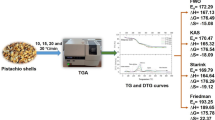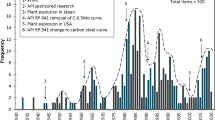Abstract
Several severe fires and explosions have happened in the past couple of decades. The major cause is addressed to the process reaction initiator. The cumulative heat effect can occur during processing, storage, and transportation. Acetic anhydride, one of the most crucial polymerization initiators, has been investigated in the present paper regarding its high thermal hazard risk. To analyze the thermal stability of acetic anhydride, a reaction calorimeter was used to determine the thermal parameters for stability assessment. We examined acetic anhydride samples under isothermal conditions of 40, 50, and 60 °C and considered factors such as stirring rate, feed rate, and temperature. The findings imply that the optimum operating environment for hydrolysis of acetic anhydride is 50 °C. The Arrhenius equation was used to determine the apparent activation energy of acetic anhydride hydrolysis as 57.77 kJ mol–1. A multiple nonlinear regression model was established to further confirm that the acetic anhydride reaction system was autocatalytic, along with an n-order reaction.









Similar content being viewed by others
Abbreviations
- ΔH a :
-
Heat release range (kJ kg–1)
- ΔH b :
-
Heat production rate range [kJ(kg·min)–1]
- ΔH d :
-
Heat of decomposition (kJ kg–1)
- A :
-
Pre-exponential factor (1 s–1)
- E a :
-
Apparent activation energy (kJ mol–1)
- k :
-
Reaction rate constant (dimensionless)
- k 0 :
-
Reaction rate constant (dimensionless)
- q r :
-
Heat release rate (W)
- R :
-
Universal gas constant [8.314 J (mol·K)–1]
- R 2 :
-
Coefficient of determination (dimensionless)
- T :
-
Reaction temperature (K)
- T r :
-
Reactor temperature (°C)
- T j :
-
Cooling jacket temperature (°C)
- TCL:
-
Conversion limit time (min)
- TMRiso :
-
Time to maximum rate under isothermal conditions (min
- \(\alpha\) :
-
Conversion degree (dimensionless)
- \(\gamma\) :
-
Conversion rate (dα dt–1)
References
Tsai YT, Huang GT, Zhao JQ, Shu CM. Dust cloud explosion characteristics and mechanisms in MgH2-based hydrogen storage materials. AlChE J. 2021. https://doi.org/10.1002/aic.17302.
Garcia JM, R.B. Bernardino I, Calasans V, Giudici R. . Kinetics of the hydrolysis of acetic anhydride using reaction calorimetry: effects of strong acid catalyst and salts. Chem Eng Res Des. 2021;166:29–39.
Garcia Hernandez EA, Souza CR, Vernières Hassimi L, Leveneur S. Kinetic modeling using temperature as an on-line measurement: application to the hydrolysis of acetic anhydride, a revisited kinetic model. Thermochim Acta. 2019;682:178409.
Ładosz A, Kuhnle C, Jensen KF. Characterization of reaction enthalpy and kinetics in a microscale flow platform. React Chem Eng. 2020;5:2115–22.
Jayakumar NS, Thomas M, Sahu JN. Experimental and modeling of a non-isothermal CSTR to find out parameter regions and conditions causing input multiplicity for acid catalyzed hydrolysis of acetic anhydride. Chemom Intell Lab Syst. 2014;135:213–22.
Hirota WH, Rodrigues RB, Sayer C, Giudici R. Hydrolysis of acetic anhydride: non-adiabatic calorimetric determination of kinetics and heat exchange. Chem Eng Sci. 2010;65:3849–58.
Gómez García MÁ, Dobrosz Gómez I, Ojeda Toro JC. Thermal stability and dynamic analysis of the acetic anhydride hydrolysis reaction. Chem Eng Sci. 2016;142:269–76.
Chen Q, Wood M, Zhao J. Case study of the Tianjin accident: Application of barrier and systems analysis to understand challenges to industry loss prevention in emerging economies. Process Saf Environ Prot. 2019;131:178–88.
Wood MH, Fabbri L. Challenges and opportunities for assessing global progress in reducing chemical accident risks. Prog Disaster Sci. 2019;4:100044.
Ponnuchamy V. A theoretical investigation of different point charges combined with GAFF and OPLS-AA for acetic anhydride. Chem Phys Lett. 2020;754:137707.
Wang Z, Cao DL, Xu ZS, Wang JL, Chen LZ. Thermal safety study on the synthesis of HMX by nitrourea method. Process Saf Environ Prot. 2020;137:282–8.
Guo ZC, Chen LP, Rao GN, Chen WH. Kinetic-parameters-free determination of thermally safe operation conditions for isoperibolic homogeneous semibatch reactions: a practical procedure. Chem Eng J. 2017;326:489–96.
Sun Y, Ni L, Papadaki M, Jiao Z, Zhu W, Jiang J, et al. Reaction hazard and mechanism study of H2O2 oxidation of 2-butanol to methyl ethyl ketone using DSC, Phi-TEC II and GC-MS. J Loss Prev Process Ind. 2020;66:104177.
Sun Y, Ni L, Papadaki M, Zhu W, Jiang J, Mashuga C, et al. Process hazard evaluation for catalytic oxidation of 2-octanol with hydrogen peroxide using calorimetry techniques. Chem Eng J. 2019;378:122018.
Zhao C, Sun J, Wang Q. Thermal runaway hazards investigation on 18650 lithium-ion battery using extended volume accelerating rate calorimeter. J Energy Storage. 2020;28:101232.
Huang AC, Li ZP, Liu YC, Tang Y, Huang CF, Shu CM, et al. Essential hazard and process safety assessment of para-toluene sulfonic acid through calorimetry and advanced thermokinetics. J Loss Prev Process Ind. 2021;72:104558.
Zhou J, Yu A-D, Suetor CG, Liang X-M, Hua M, Pan X-H, et al. Risk assessment of polyarylether polymerization process. J Therm Anal Calorim. 2020;144:295–303.
Yuan C, Chen W, Yang Z, Huang Z, Yu X. The effect of various cations/anions for MgH2 hydrolysis reaction. J Mater Sci Technol. 2021;73:186–92.
Sahu JN, Mahalik KK, Patwardhan AV, Meikap BC. Equilibrium studies on hydrolysis of urea in a semi-batch reactor for production of ammonia to reduce hazardous pollutants from flue gases. J Hazard Mater. 2009;164:659–64.
Sahu JN, Hussain S, Meikap BC. Computational fluid dynamics modeling for urea hydrolysis in a batch reactor for flue gas conditioning. Chem Eng Technol. 2011;34:1347–52.
Mahalik K, Sahu JN, Patwardhan AV, Meikap BC. Statistical modelling and optimization of hydrolysis of urea to generate ammonia for flue gas conditioning. J Hazard Mater. 2010;182:603–10.
Huang AC, Huang CF, Tang Y, Xing ZX, Jiang JC. Evaluation of multiple reactions in dilute benzoyl peroxide concentrations with additives using calorimetric technology. J Loss Prev Process Ind. 2021;69:104373.
Huang AC, Liao FC, Huang CF, Tang Y, Zhang Y, Shu CM, et al. Calorimetric approach to establishing thermokinetics for cosmeceutical benzoyl peroxides containing metal ions. J Therm Anal Calorim. 2021;144:373–82.
Shatynski JJ, Hanesian D. Adiabatic kinetic studies of the cytidine/acetic anhydride reaction by utilizing temperature versus time data. Ind Eng Chem Res. 1993;32:594–9.
Tseng JM, Lin CP. Prediction of incompatible reaction of dibenzoyl peroxide by isothermal calorimetry analysis and green thermal analysis technology. J Therm Anal Calorim. 2011;107:927–33.
Huang AC, Huang CF, Xing ZX, Jiang JC, Shu CM. Thermal hazard assessment of the thermal stability of acne cosmeceutical therapy using advanced calorimetry technology. Process Saf Environ Prot. 2019;131:197–204.
Liu SH, Cao CR, Lin WC, Shu CM. Experimental and numerical simulation study of the thermal hazards of four azo compounds. J Hazard Mater. 2019;365:164–77.
Cao CR, Liu SH, Das M, Shu CM. Evaluation for the thermokinetics of the autocatalytic reaction of cumene hydroperoxide mixed with phenol through isothermal approaches and simulations. Process Saf Environ Prot. 2018;117:426–38.
Chen WC, Lin JR, Liao MS, Wang YW, Shu CM. Green approach to evaluating the thermal hazard reaction of peracetic acid through various kinetic methods. J Therm Anal Calorim. 2016;127:1019–26.
Gómez García MÁ, Dobrosz-Gómez I, Ojeda Toro JC. Thermal stability and dynamic analysis of the acetic anhydride hydrolysis reaction. Chem Eng Sci. 2016;142:269–76.
Yang YP, Huang AC, Tang Y, Liu YC, Wu ZH, Zhou HL, et al. Thermal stability analysis of lithium-ion battery electrolytes based on lithium bis(trifluoromethanesulfonyl)imide-lithium difluoro(oxalato)borate dual-salt. Polymers (Basel). 2021;13:707.
Tsai YT, Yang Y, Huang HC, Shu CM. Inhibitory effects of three chemical dust suppressants on nitrocellulose dust cloud explosion. AIChE Journal. 2020. https://doi.org/10.1002/aic.16888.
El Hazzat M, Sifou A, Arsalane S, El Hamidi A. Novel approach to thermal degradation kinetics of gypsum: application of peak deconvolution and Model-Free isoconversional method. J Therm Anal Calorim. 2019;140:657–71.
Huang AC, Chen WC, Huang CF, Zhao JY, Deng J, Shu CM. Thermal stability simulations of 1,1-bis(tert-butylperoxy)-3,3,5 trimethylcyclohexane mixed with metal ions. J Therm Anal Calorim. 2017;130:949–57.
Wang Q, Liu SH, Huang AC, Huang CF, Chuang YK, Shu CM. Effects of mixing malic acid and salicylic acid with metal oxides in medium- to low-temperature isothermal conditions, as determined using the thermal activity monitor IV. J Therm Anal Calorim. 2018;133:779–84.
Cheng YF, Liu SH, Shu CM, Zhang B, Li YF. Energy estimation and modeling solid thermal explosion containment on reactor for three organic peroxides by calorimetric technique. J Therm Anal Calorim. 2017;130:1201–11.
Cao CR, Liu SH, Shu CM. Reaction simulation of multistage evaluations for AMBN based on DSC experiments. Thermochim Acta. 2018;661:18–26.
Acknowledgements
The authors thank the National Nature Science Foundation of China (No. 21927815), the National Key Research Development Program of China (No. 2019YFC0810701), Jiangsu Province Postgraduate Research and Practice Innovation Project (KYCX21_2802), and General Natural Science Research Project of Jiangsu Universities in 2020 (No. 20KJB620002) for financial support.
Author information
Authors and Affiliations
Corresponding author
Additional information
Publisher's Note
Springer Nature remains neutral with regard to jurisdictional claims in published maps and institutional affiliations.
Rights and permissions
About this article
Cite this article
Liu, YC., Huang, AC., Tang, Y. et al. Thermokinetic analysis of the stability of acetic anhydride hydrolysis in isothermal calorimetry techniques. J Therm Anal Calorim 147, 7865–7873 (2022). https://doi.org/10.1007/s10973-021-11065-x
Received:
Accepted:
Published:
Issue Date:
DOI: https://doi.org/10.1007/s10973-021-11065-x




